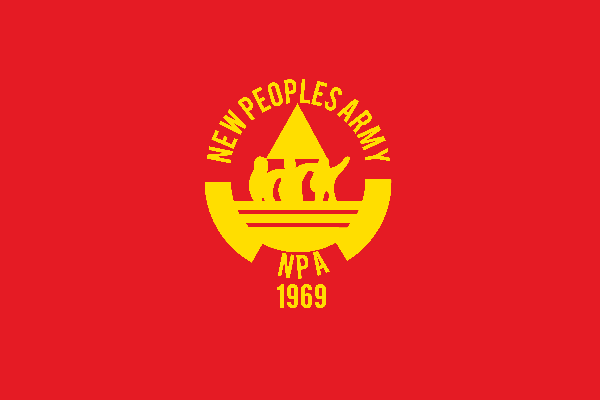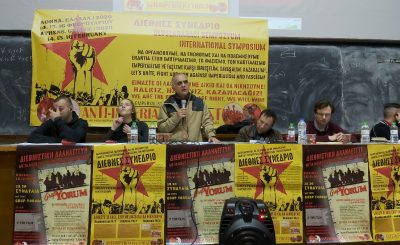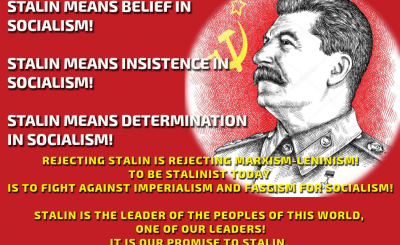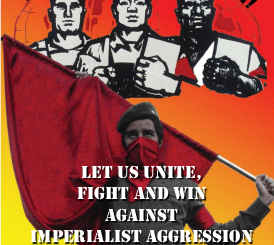I. Marxism-Leninism as Guide to Revolution in the Era of Modern Imperialism and Proletarian Revolution
The world is still in the era of modern imperialism and proletarian revolution. The description remains valid, especially because what was conceived of as the third stage of the general crisis of capitalism involving the struggle between the capitalist camp and the socialist camp (augmented by the national liberation movements) and resulting in the triumph of the socialist camp has not run the course as expected. The betrayal of the socialist cause by modern revisionism has brought about the disintegration of the socialist camp. But this is merely a temporary setback in the forward march of the world proletarian revolution.
Lenin’s thesis on modern imperialism as the eve of the world proletarian revolution has been confirmed and firmly established by the successful revolutions in Russia, China, Indochina and others notwithstanding the subsequent modern revisionist betrayal. The fundamental teachings of Marxism-Leninism retain their basic validity and will be upheld in the next round of new-democratic and socialist revolutions.
In tracing the historical destiny of the doctrine of Karl Marx in 1913, Lenin marked three periods: the first, from the revolution of 1848 to the Paris Commune of 1871; the second, from the Paris Commune to the Russian Revolution of 1905, and the third, since the Russian revolution.
In the first period, the doctrine of Marx was proclaimed by the Communist Manifesto. It started out as only one of the numerous trends of socialism. The revolutionary storms revealed the various classes in action and established the fact that the proletariat alone could lead the socialist revolution. Bourgeois society took shape. Liberalism was exposed as a tool of reaction. Pre-Marxian utopian trends of socialism were swept away. Independent proletarian parties were born: the First International (1864-72) and the German Social-Democratic Party.
In the second period (1872-1904), there were generally no revolutionary storms in the West inasmuch as in the main it had finished with bourgeois revolutions. Socialist parties, basically proletarian, were organized on a wide scale. The Marxian doctrine spread and was so predominant in the working class movement that liberalism tried to revitalize itself in the form of socialist opportunism.
In the third period, the East opened up in a big way as the source of great revolutionary storms. The bourgeois democratic revolutions in Russia, Turkey, Persia and China broke out one after another. Here we may point out that the pioneer of the bourgeois-democratic revolutions in Asia was the Philippine revolution of 1896.
Lenin recognized the growing importance of the East as the battlefield between the proletariat and the bourgeoisie. He pointed out the potential dialectical interaction between the revolutionary movement in the East and that in the West. He was on the road of extending and further developing Marxism of 19th century free-competition capitalism to the stage of Leninism in the era of modern imperialism and proletarian revolution.
In working out his theory, Lenin had to fight the opportunists and revisionists of the Second International who acted as the social chauvinist and social pacifist tail of the direct parliamentary agents of the monopoly bourgeoisie in exploiting the proletariat in Europe, in raising war budgets and in encouraging imperialist policy and projects. Kautsky’s theory of ultra-imperialism even went so far as to presume that imperialism is benign and progressive because it is supposed to break down precapitalist formations and open the way to capitalist development and the growth of the proletariat in colonies and semicolonies.
Lenin categorically described imperialism as moribund capitalism and as the eve of socialist revolution. He put forward the theory of uneven development in order to demonstrate that imperialism involves the spasmodic and uneven expansion of capital and at the same time in a bigger way the destruction of productive forces in the wake of taking superprofits from the colonies, semicolonies and the dependent countries; and that where the oppression and exploitation is most intense on a wide scale revolutionary resistance arises. Thus, in addition to the slogan “workers of all countries, unite!”, he issued the slogan for the oppressed peoples and nations to unite against imperialism and local reaction.
Under the theory of uneven development, Russia was the weakest link in the chain of imperialist countries and was where the proletarian revolution was most likely to win, provided the subjective forces were developed to take advantage of the ripening revolutionary situation. The economic and technological conditions in the stronger imperialist countries are more apt for socialism than those in the less-developed countries but their social and military power at home plus the superprofits taken from colonies and semicolonies provide the imperialists with more resources to preempt, crush or derail the proletarian revolution.
Lenin estimated that workers’ uprisings in the West, especially in Germany would be helpful to the Russian revolution. But when these failed, he became even more determined to encourage the bourgeois-democratic revolutions in the East and place them within the framework of the world proletarian revolution. Thus, soon after the victory of the October revolution, he proceeded to form the Third International in 1919 in order to promote the building of proletarian revolutionary parties in both the imperialist countries and the countries dominated by imperialism.
II. Worsening Crisis of World Capitalist System: Increased Oppression and Exploitation in Neocolonies
The crisis of the world capitalist system is becoming sharper than ever before and is intensifying the suffering of the people. The crisis is more acutely felt many times over in the so-called countries of the third world where about 80 percent of the world population are still mired in agrarian backwardness. In these countries, underdevelopment and poverty have been aggravated and deepened by the neocolonialism of monopoly capitalism. Contrary to the claim that monopoly capitalism has spread development on a global scale, the countries of the third world have suffered economic degradation and de-industrialization.
The overwhelming majority of third world countries have been victimized by being compelled under neocolonialism to take foreign investments and loans for expanding raw-material production and infrastructure and suffer ever deteriorating terms of trade between their raw-material exports and manufactured imports. Since the ’70s, their economies have been ruined by the overproduction of raw materials for export, by ever deteriorating terms of trade and by mounting deficit and foreign debt problems. They have been prevented from building their own industrial foundation.
While the three global centers of capitalism (US, Japan and the European Union) are intensifying their competition, they continue to be united in shifting the burden of the capitalist crisis to the third world countries as well as to the countries previously dominated and devastated by Soviet social-imperialism. All these subjugated countries are now compelled to press down the level of their development and to absorb the surplus commodities and surplus capital from the global centers of capitalism in a manner as to prevent their own industrial development.
Under neocolonialism, surplus capital in the form of direct and indirect investments has been used mainly to finance consumption, raw-material production, bureaucratic corruption and military buildup and only secondarily for spotty and lopsided development of some basic industries and export-oriented manufacturing in a few third world countries.
In all the neocolonial client-states, foreign monopoly capitalism and the local reactionaries are undermining and brazenly curtailing the trade union and other rights of the working class and are pressing down wage levels for the purpose of attracting foreign investments and in the name of development and social accord.
It is not true that simply because the wage levels in third world countries are at least ten times lower than those in the industrial capitalist countries, the imperialists are shifting their industries to the third world. The imperialists make sure that they retain the industrial core processes and the most advanced technology, that they do not create more industrial countries to compete with them and that they put a brake on unemployment and social unrest in their own countries as much as possible. Thus, only to some limited extent and in a begrudging way do they allow some industries in the third world. Their antagonism towards proletarian revolutionaries in the third world is precisely because these fight for national independence and the industrial development of their own countries.
Even the handful of economies, previously allowed during the cold war to engage in export-oriented manufacturing and to use savings to build some basic industries, are now suffering from rising trade deficits and a deepening depression due to the overproduction of cheap consumer manufactures for the imperialist countries.
Membership in what can be called the league of underdeveloped countries has increased. Entire basic industries have disintegrated or closed down in the former Soviet Union and in Eastern Europe. In the main, surplus manufactures are being dumped on them from the West.
The imperialist curse of underdevelopment, mass unemployment, inflation and widespread social misery, the plunder of natural resources and ravaging of the environment can be ended only through the people’s armed revolutionary movement to overthrow the counterrevolutionary state and establish the people’s democratic state under working class leadership. This paves the way for the socialist revolution.
III. Main Contradiction Between Imperialism and People in Neocolonies (“Third World” and Countries Betrayed by Modern Revisionism)
The contradiction between imperialism and the people in neocolonies (i.e. the “Third World” and countries betrayed by modern revisionism) stands out as the main contradiction in the world today. Through the use of neocolonialism and wars of aggression, the imperialists have carried out the most bitter oppression and exploitation and the ruination of national economies in Asia, Africa and Latin America and in the former Soviet bloc countries in Eastern Europe and elsewhere. The 80 percent of the world population that live below the poverty line are concentrated in these countries.
The intolerable economic dictates, blockades, intervention and aggression of the imperialist countries and the conflicts of reactionary cliques using the slogans of nationalism, ethnocentrism and religion are currently generating instability, tension and violence on a wide scale.
There are revolutionary movements led by the revolutionary parties of the proletariat but are still few as a result of imperialist suppression, neocolonialism and revisionist betrayal. Even then the struggle between armed revolution and armed counterrevolution is focused on the countries of the oppressed peoples and nations.
Some of the most notable revolutionary movements waging armed struggle are those in the Philippines, Kampuchea, India, Nepal, Bangladesh, Peru, Mexico, Colombia, Turkey and Kurdistan. The perseverance of the people in revolutionary armed struggle in these countries is highly significant amidst the degradation of armed conflicts into the most vicious struggle for power among reactionary cliques that offers no bright future to the people and that often involves the manipulation of ethnic and religious differences by at least one side.
In the third world and former Soviet-bloc countries, which are suffering from basically semicolonial and semifeudal conditions, it is possible and necessary to build revolutionary parties of the proletariat that can lead the broad masses of the people in the new-democratic and socialist stages of the revolution. In these countries, the people are now far more predisposed than those in the imperialist countries to wage armed revolution. The resurgence of the armed revolutionary movement in these countries can stimulate the forces of proletarian revolution in the imperialist countries.
IV. Violence and Deception by Imperialism
The monopoly bourgeoisie uses high-tech media to play up the so-called failure of socialism and all kinds of sensational events in order to obscure the growing class struggle in the industrial capitalist countries and in the neocolonies. While Marxists-Leninist parties are still small or absent, the new social-democratic, old social-democratic and green parties offer themselves as alternatives to the traditional parties of the big bourgeoisie.
The monopoly bourgeoisie systematically uses petty-bourgeois ideology and propaganda to preempt, slander and discredit Marxism-Leninism and socialism. It is funding petty-bourgeois dominated “non-governmental” organizations as tools for obscuring the responsibility of imperialism and local reaction for the widespread poverty, environmental destruction, ethnic conflicts, gender discrimination and so on.
Since the 80s, monopoly capitalism has dulled the perception of economic devastation wrought by neocolonialism through the sham promotion of bourgeois democracy or the replacement of military juntas and authoritarian regimes which were in the first place instigated and installed for the most part by US imperialism in the 70s, the bourgeois media hype about the myth of the global free market citing the so-called “success” stories of East Asia (the four tigers and the coastal provinces of China) and the promotion of “peaceful settlement” of “regional conflicts” and civil wars.
But the bourgeois “democratization” pushed by the Reagan administration in Latin America and Asia in the 80s has become overstrained by the ever worsening economic and social crisis. The “peaceful resolution of regional armed conflicts” promoted by the United States and the Soviet Union in Iraq and Iran, Central Asia (particularly Afghanistan), southern Africa (South Africa and Angola), Central America (Nicaragua and El Salvador) and Indochina (Kampuchea) is either under severe strain or is already in shambles.
In several major capitalist countries, parties, groups and movements of bourgeois nationalism, neofascism, racism, ethnocentrism and religious prejudices are arising and being funded by certain sections of the monopoly bourgeoisie to preempt and threaten the progressive forces and to give the state authorities the pretext to suppress the progressive forces, especially the Marxist-Leninist parties and organizations.
The worst reactionary forces are conspicuously at work, where civil wars and ethnic and religious conflicts are raging, in the former revisionist-ruled bureaucrat capitalist states and in the third world countries. The domestic big bourgeoisie and other reactionaries have used these armed conflicts to consolidate their power over the people. The imperialists have also fanned these conflicts and used them as pretext for intervention and takeover.
In third world countries where the revolutionary armed struggle is being waged and is led by the proletarian party, the imperialists use the “low-intensity conflict strategy” which employs both psychological warfare and armed force to suppress the revolutionary movement. The puppet regimes are propped up through various forms of economic and military aid. Without such aid these regimes would collapse both under the weight of the internal crisis of the moribund local ruling system and the effective blows of the armed revolution.
V. Revolutionary Armed Struggle: Answer to the Central Question of Revolution / Now and in the 21st Century
Marxism-Leninism teaches us that the reactionary state is essentially an instrument for suppressing the oppressed and exploited classes and for maintaining the rule of the oppressors and exploiters. Armed force is its principal weapon of suppression. The central task of any revolution therefore is the forcible overthrow of the reactionary classes and the armed seizure of power by the oppressed and exploited classes. The victorious revolution then proceeds to use its own state power to suppress the resistance of the overthrown exploiting classes and build a new social order.
At present, it is in some countries of the third world that revolutionary movements are addressing the central question of revolution: the armed seizure of political power. Though still few in number, they are playing the role of being the revolutionary pioneers in a period of unprecedented crisis and great disorder. They keep high the hope of the proletariat and peoples of the world for the resurgence of the antiimperialist and socialist movement.
The new world disorder that has arisen in the wake of the end of the Cold War provides favorable conditions for the resurgence of revolutionary movements led by the proletariat in the imperialist and imperialist-dominated countries. The violent conflict in many parts of the world due to the bitter rivalries of reactionary factions under worsening socioeconomic conditions, the growing military interventions of imperialist powers and the sharpening competition of the imperialist powers themselves as a result of the crisis of overproduction are preparing the stage for interimperialist war as well as for revolutionary wars on an unprecedentedly wide scale in the forthcoming century.
VI. Proletarian Internationalism and Antiimperialist Solidarity of Peoples
In the current situation, it is more urgent than ever for the workers and peoples of the world to unite and advance the revolutionary struggle against imperialism and for socialism. The ever worsening crisis of the world capitalist system and the ever escalating oppression and exploitation are prodding the proletarian revolutionaries and peoples of various countries to reaffirm the theory and practice of Marxism-Leninism.
In accordance with the principle of proletarian internationalism, antiimperialist and socialist movements, parties and organizations must strive to engage in all possible ways to develop mutual understanding, fraternal relations and mutual support and cooperation.
But the best kind of support that revolutionary movements can give to one another and the best contribution that they can make to the world proletarian revolution is to make advances and when possible win total victory in their respective revolutionary struggles against imperialism and all reaction. And they can make advances and win victories only by following and carrying out the principle of self-reliance while taking advantage of and being grateful for any necessary and appropriate foreign assistance but taking care not to become dependent on it.
The current socio-economic crisis and turmoil in the world capitalist system is setting the stage for the next round in the epochal struggle between the forces of socialism and democracy and those of imperialism and reaction. With the imperialist powers becoming more and more violently at odds with each other and their puppets becoming more and more overburdened by all-round socio-economic crisis, the proletariat and oppressed peoples and nations can once again take the initiative of fighting for national liberation, democracy and socialism. We can look forward to great struggles and great victories of the proletarian revolution in the 21st century.




